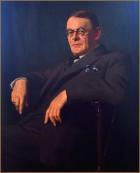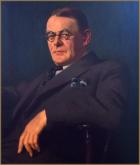"Cowan Dobson"
Sir John Alexander Hammerton, (1871–1949), author and editor of reference works, was born in Alexandria, Dunbartonshire, on 27 February 1871, the second in a family of two sons and one daughter of James Hammerton (1832/3–1874/5), clog maker of Oldham, and his second wife, Janet (b. 1841/2), shopwoman, daughter of Alexander Lang, mason. His father died when he was aged three, and the family, then living in Manchester, returned to the home of their maternal grandmother in Scotland. He attended first the Freeland School, Glasgow, and then Alexander's endowed school in the same city. As the breadwinner in the family, he left school at fourteen, and for the next four years he was apprenticed as a sculptor and tomb-cutter to the firm of stonemasons J. & G. Mossman. During this time he attended evening classes at the City School and at Glasgow University. He was known to his friends as Sandy.
The most successful creator of large-scale works of reference that Britain has known, Hammerton began his journalistic career in 1889 as a reporter on the Scottish temperance paper The Reformer. His light, humorous sketches began to appear regularly in London newspapers and in periodicals such as Punch. A succession of posts in journalism took him to Bolton, Blackpool, Nottingham, and Birmingham. While working in Blackpool, he married, on 3 January 1895, Rhoda (1871/2–1948), daughter of Colin Gibb Lawrence, of Glasgow. In 1900 he settled in London, where his lively, robust style of writing caught the eye of the founder of modern popular journalism, Alfred Harmsworth. In 1905 Hammerton was invited to join Harmsworth's Amalgamated Press, then the largest periodical-publishing empire in the world, and for the next seventeen years his employer's energetic and 'radium-like personality', as described by Hammerton, provided him with the background to his life's work. Of the more than ten million bound editions that bear his name as editor or author, he was proudest of the fortnightly Harmsworth's Universal Encyclopedia (1920–22) which, under the slogan of 'a penny a day's subscription', sold twelve million copies throughout the English-speaking world and was translated into six languages, including Japanese.
In 1911–13 Hammerton lived in Buenos Aires, where he edited El diccionario encyclopédico Hispano-Americano. He also wrote under pseudonyms, most notably a novel, The Call of the Town (1904), light reminiscences, and biographies of, among others, Arthur Mee and Sir J. M. Barrie. Despite the shortage of paper and the requisitioning of most commercial photographic glass negatives for the war effort, he was never happier, as he recounts in his autobiography, Books and Myself (1944), than during those days in the First World War when he worked late into the night to the background of a pavement barrel-organ in the Farringdon Road, alert to imminent air attacks on the city.
Hammerton's formative influence as a boy had been John Cassell's Popular Educator, first published in 1852. In 1934 he was able to consummate, in his own words, 'one of the romances of modern publishing', by revising and reissuing the work under the new title Practical Knowledge for All, which was, in turn, to become the most familiar series of educational books in millions of homes for a new generation.
To Hammerton's gifts of communication must also be attributed that most popular of all gestures of the twentieth century: the ‘V’ sign. In late 1940 he reported in the War Illustrated his sighting of a 'V' for victory sign apparently blazed by a Hawker Hurricane in the sky over the village of Firle in Sussex. Within months the sign had replaced the customary ‘thumbs-up’ and had been adopted throughout beleaguered Europe as a symbol of defiance to Nazism.
A lifelong enthusiast of the stage, Hammerton first fell under the spell of music-hall as a boy in Glasgow; from then on he attended performances of all the great variety artists of the day, and for a brief spell managed his own theatre company in Eastbourne. In 1926 he settled near Eastbourne, where he became a familiar sight driving at speed in his superb Lagonda through the Sussex lanes.
Hammerton was knighted in 1932 and was subsequently made a fellow of the Royal Society of Arts and of the Royal Society of Edinburgh. After his first wife's death in 1948 he married on 12 February 1949 his long-time friend and collaborator, the actress and journalist (Kate) Janet Maitland (1878–1961), daughter of Charles Dallas Alexander, of independent means, and widow of the actor Lauderdale Maitland. He died on 12 May 1949 at the Mayfair Hotel in Westminster, London.
David Cowan Dobson (1894–1980), ARBA, RBA, was a leading Scottish portrait artist. Dobson was born in Bradford to Scottish parents and around 1920 moved to London.
Dobson was born in Bradford, Yorkshire, the second son of the Scottish portrait painter Henry John Dobson (1858–1928) and Jeannie Charlotte Hannah Cowan. Henry John Dobson was from St. John's Town of Dalry in Galloway and had painted, in 1893, the Labour leader James Keir Hardie. David's middle name which he used professionally derives from his mother's maiden name. His grandfather, Thomas Dobson, was a wool merchant in the town of Kirkcudbright. It is said in the family that there was a Dobson wool mill in Dalry, owned and run by Thomas. Henry John did not maintain the family tradition of running the family wool business, and instead became an artist. Family legend has it that Thomas Dobson disowned his son. Henry John's whole life would be marked by financial difficulties.
The oldest child of the Dobson family was Thomas Stanley Dobson, born in 1892 and named after his grandfather. He was known as Stanley Dobson, and became an actor. To make ends meet, Stanley also worked for an art dealer in London. The only sister was Louisa Rankin Dobson (b. 1896), known as Louie. She had an intense family bond with her brothers, but mainly with her younger brother and fourth child, Henry Raeburn Dobson (1901–1985), for whom she cared lifelong. He was named after the eighteenth-century Scottish portrait painter, Sir Henry Raeburn (1756–1823), whom his father admired hugely. Henry Raeburn Dobson became a leading society portrait painter in Edinburgh and Brussels.
Although he painted some fine portraits of well known men, like Earl Attlee, Earl Beatty and Harold Wilson, Dobson also portrayed "fashionable London ladies". Dobson was married to Phyllis Bowyer, who was the brains behind his financial success. She made Dobson one of London's leading society portrait painters. She herself sat for the photographer Alexander Bassano, the resulting portrait now being at the National Portrait Gallery, London.
Dobson started his career in Scotland. He was educated at George Watson's College in Edinburgh and studied art in Edinburgh, London and Paris. In 1918 he was using his father's studio at Dalry. Around 1920 he moved to London and from then on he worked and resided mainly in London. Occasionally, he would work in and around Glasgow. He is said to have rented Kenmure Castle, in New Galloway, Kirkcudbrightshire, in the 1930s and 1940s to entertain and paint fashionable sitters. His older brother Thomas Stanley ran the castle as a hotel in the 1950s.
Dobson mainly worked in oils but also painted some fine water-colour scenes. He painted in the tradition of the academic nineteenth century with mostly a rather darker colour scheme, while his brother Henry, influenced by the Modernist movement in Edinburgh, painted more colourful portraits.
During World War I, Dobson was commissioned by the Royal Air Force section of the Imperial War Museum to paint portraits of three recipients of the Victoria Cross. Dobson painted portraits of Lt. Col. L.W. Brabazon Rees, Sgt Mottershead and Flight Lt. A.W. Beauchamps-Proctor.
Dobson first exhibited at Royal Academy when aged only nineteen and began showing at the Royal Scottish Academy four years later. Dobson's works were also exhibited at the Royal Society of Arts, Royal Watercolour Society, Royal Society of Portrait Painters, Royal Society of British Artists, Royal Cambrian Academy, Fine Art Society and at the Walker Art Gallery in Liverpool.
Some works
-
The Farmer (1915) 51 x 61 inches
-
Harry Lauder (1915) 62 x 44 inches. (In the possession of the family.)
-
Captain John Lauder, Argyll & Sutherland Highlanders (1915) 87 x 50 inches.(Family.)
-
Portrait of a young lady (head & shoulders) (1918) 38 x 48 inches
-
The New Toy (1918) 59.5 x 74 cm
-
Lady Lauder (1921) (wife of Sir Harry Lauder) 50 x 40 inches. (Family.)
-
After the Ball (1922) 102 x 76 cm.
-
Henry John Dobson (1923), the artist's father. National Gallery of Scotland.[5]
-
William Lowrie Sleigh; Lord Provost of Edinburgh (1926) City of Edinburgh Council
-
Portrait of a girl with a Rag Doll (1927) 127 x 76 cm
-
Portrait of a Huntsman (1930) 61 x 51 inches
-
Admiral Lord Beatty in full evening dress (1930) 65 x 52 inches (last sold at Burnt Oak Auctions, Woking, Surrey, 24 September 1988).
-
Girl in a Green Turban (1932) 15.4 x 9.3 inches (Sothebys, London, 12 October 1988).
-
Roses in a bowl on a circular table (1938) (Hall's Welsh Bridge Salerooms, UK, 16 June 2006)
-
Reclining nude 50.8 x 66 inches (Christies, South Kensington, London, 11 March 2004).
-
On a sandy beach 50 x 40.2 inches (Sothebys, London, 28 August 1990).
-
Moll Flanders (1954) 76 x 63.5 cm/ 30 x 25 inches
-
Clement Attlee (1956)
-
The Duke of Argyll
-
Sir John Black 61 x 51 inches.
-
Mrs Cowan Dobson 95 x 74.7 cm
-
The Countess of Weir 128 x 101.5 cm.
-
Viscount Mackintosh of Halifax 85 x 70 cm. (d.27 Dec 1964)
-
Harold Wilson, Prime Minister of Great Britain.



